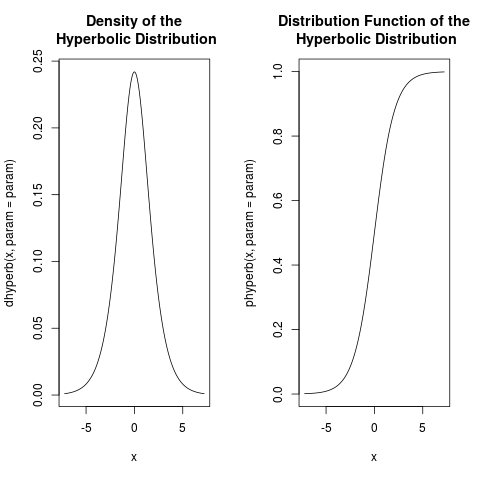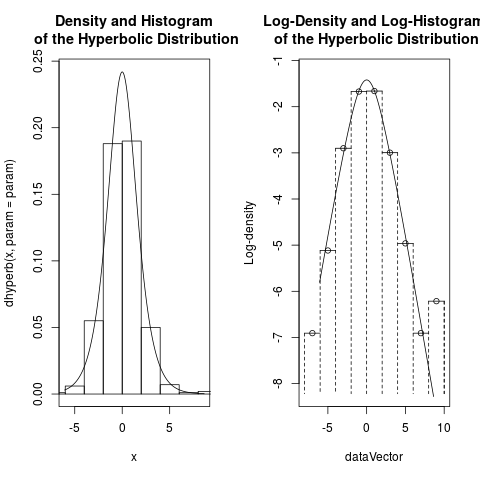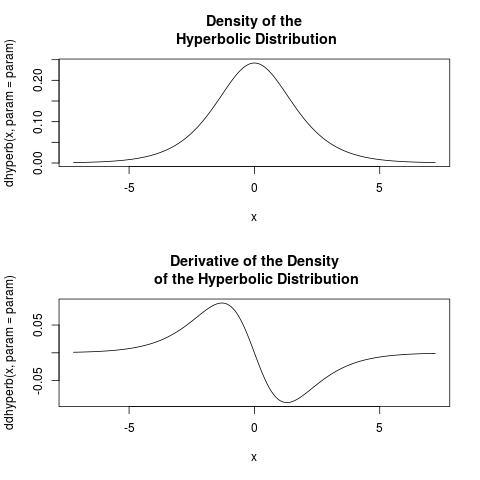Supported by Dr. Osamu Ogasawara and  providing providing  . . |
|
Last data update: 2014.03.03 |
Hyperbolic DistributionDescriptionDensity function, distribution function, quantiles and
random number generation for the hyperbolic distribution
with parameter vector Usage
dhyperb(x, mu = 0, delta = 1, alpha = 1, beta = 0,
param = c(mu, delta, alpha, beta))
phyperb(q, mu = 0, delta = 1, alpha = 1, beta = 0,
param = c(mu, delta, alpha, beta),
lower.tail = TRUE, subdivisions = 100,
intTol = .Machine$double.eps^0.25,
valueOnly = TRUE, ...)
qhyperb(p, mu = 0, delta = 1, alpha = 1, beta = 0,
param = c(mu, delta, alpha, beta),
lower.tail = TRUE, method = c("spline", "integrate"),
nInterpol = 501, uniTol = .Machine$double.eps^0.25,
subdivisions = 100, intTol = uniTol, ...)
rhyperb(n, mu = 0, delta = 1, alpha = 1, beta = 0,
param = c(mu, delta, alpha, beta))
ddhyperb(x, mu = 0, delta = 1, alpha = 1, beta = 0,
param = c(mu, delta, alpha, beta))
Arguments
DetailsThe hyperbolic distribution has density f(x)=1/(2 sqrt(1+pi^2) K_1(zeta)) exp(-zeta(sqrt(1+pi^2) sqrt(1+((x-mu)/delta)^2)-pi (x-mu)/delta)) where K_1() is the modified Bessel function of the third kind with order 1. A succinct description of the hyperbolic distribution is given in Barndorff-Nielsen and Bl<c3><a6>sild (1983). Three different possible parameterizations are described in that paper. A fourth parameterization is given in Prause (1999). All use location and scale parameters mu and delta. There are two other parameters in each case. Use Each of the functions are wrapper functions for their equivalent
generalized hyperbolic counterpart. For example, The hyperbolic distribution is a special case of the generalized
hyperbolic distribution (Barndorff-Nielsen and Bl<c3><a6>sild
(1983)). The generalized hyperbolic distribution can be represented as
a particular mixture of the normal distribution where the mixing
distribution is the generalized inverse Gaussian. Value
Author(s)David Scott d.scott@auckland.ac.nz, Ai-Wei Lee, Jennifer Tso, Richard Trendall ReferencesBarndorff-Nielsen, O. and Bl<c3><a6>sild, P (1983). Hyperbolic distributions. In Encyclopedia of Statistical Sciences, eds., Johnson, N. L., Kotz, S. and Read, C. B., Vol. 3, pp. 700–707. New York: Wiley. Dagpunar, J.S. (1989). An easily implemented generalized inverse Gaussian generator Commun. Statist. -Simula., 18, 703–710. Prause, K. (1999) The generalized hyperbolic models: Estimation, financial derivatives and risk measurement. PhD Thesis, Mathematics Faculty, University of Freiburg. See Also
Examples
param <- c(0, 2, 1, 0)
hyperbRange <- hyperbCalcRange(param = param, tol = 10^(-3))
par(mfrow = c(1, 2))
curve(dhyperb(x, param = param), from = hyperbRange[1], to = hyperbRange[2],
n = 1000)
title("Density of the\n Hyperbolic Distribution")
curve(phyperb(x, param = param), from = hyperbRange[1], to = hyperbRange[2],
n = 1000)
title("Distribution Function of the\n Hyperbolic Distribution")
dataVector <- rhyperb(500, param = param)
curve(dhyperb(x, param = param), range(dataVector)[1], range(dataVector)[2],
n = 500)
hist(dataVector, freq = FALSE, add =TRUE)
title("Density and Histogram\n of the Hyperbolic Distribution")
logHist(dataVector, main =
"Log-Density and Log-Histogram\n of the Hyperbolic Distribution")
curve(log(dhyperb(x, param = param)), add = TRUE,
range(dataVector)[1], range(dataVector)[2], n = 500)
par(mfrow = c(2, 1))
curve(dhyperb(x, param = param), from = hyperbRange[1], to = hyperbRange[2],
n = 1000)
title("Density of the\n Hyperbolic Distribution")
curve(ddhyperb(x, param = param), from = hyperbRange[1], to = hyperbRange[2],
n = 1000)
title("Derivative of the Density\n of the Hyperbolic Distribution")
Results
R version 3.3.1 (2016-06-21) -- "Bug in Your Hair"
Copyright (C) 2016 The R Foundation for Statistical Computing
Platform: x86_64-pc-linux-gnu (64-bit)
R is free software and comes with ABSOLUTELY NO WARRANTY.
You are welcome to redistribute it under certain conditions.
Type 'license()' or 'licence()' for distribution details.
R is a collaborative project with many contributors.
Type 'contributors()' for more information and
'citation()' on how to cite R or R packages in publications.
Type 'demo()' for some demos, 'help()' for on-line help, or
'help.start()' for an HTML browser interface to help.
Type 'q()' to quit R.
> library(GeneralizedHyperbolic)
Loading required package: DistributionUtils
Loading required package: RUnit
> png(filename="/home/ddbj/snapshot/RGM3/R_CC/result/GeneralizedHyperbolic/dhyperb.Rd_%03d_medium.png", width=480, height=480)
> ### Name: Hyperbolic
> ### Title: Hyperbolic Distribution
> ### Aliases: dhyperb phyperb qhyperb rhyperb ddhyperb
> ### Keywords: distribution
>
> ### ** Examples
>
> param <- c(0, 2, 1, 0)
> hyperbRange <- hyperbCalcRange(param = param, tol = 10^(-3))
> par(mfrow = c(1, 2))
> curve(dhyperb(x, param = param), from = hyperbRange[1], to = hyperbRange[2],
+ n = 1000)
> title("Density of the\n Hyperbolic Distribution")
> curve(phyperb(x, param = param), from = hyperbRange[1], to = hyperbRange[2],
+ n = 1000)
> title("Distribution Function of the\n Hyperbolic Distribution")
> dataVector <- rhyperb(500, param = param)
> curve(dhyperb(x, param = param), range(dataVector)[1], range(dataVector)[2],
+ n = 500)
> hist(dataVector, freq = FALSE, add =TRUE)
> title("Density and Histogram\n of the Hyperbolic Distribution")
> logHist(dataVector, main =
+ "Log-Density and Log-Histogram\n of the Hyperbolic Distribution")
> curve(log(dhyperb(x, param = param)), add = TRUE,
+ range(dataVector)[1], range(dataVector)[2], n = 500)
> par(mfrow = c(2, 1))
> curve(dhyperb(x, param = param), from = hyperbRange[1], to = hyperbRange[2],
+ n = 1000)
> title("Density of the\n Hyperbolic Distribution")
> curve(ddhyperb(x, param = param), from = hyperbRange[1], to = hyperbRange[2],
+ n = 1000)
> title("Derivative of the Density\n of the Hyperbolic Distribution")
>
>
>
>
>
> dev.off()
null device
1
>
|


